Product page SEO is the practice of optimizing your e-commerce product pages to rank higher in search engine results and generate more sales.
When doing SEO for product pages, you must consider other factors beyond traditional SEO practices. Your overall goal is to create pages that offer a great user experience, are easy to crawl by search engines, and are optimized for conversions.
Product Page SEO Tips
Follow these tips to optimize your product pages for SEO:
- Refine Product URLs
- Optimize Product Titles
- Enhance Product Page Headings
- Craft Compelling Meta Descriptions
- Improve Breadcrumb Navigation
- Write Unique Product Descriptions
- Use High-Quality Images
- Add Product Videos Properly
- Implement Product Schema Markup
- Highlight Product Reviews And Ratings
- Leverage User-Generated Content
- Strategize Cross-Selling
1. Refine Product URLs
The first element that needs your attention is the product URL. Although it's not the most critical SEO ranking factor, having properly optimized product URLs is recommended for several reasons.
- It's easier for search engines and users to understand
- It's useful for readability, especially when a product URL is shared in forums or social media platforms.
For example, it's easier to understand that this URL: http://www.example.com/products/macbookpro-256gb will lead to a product page about a 256GB Macbook Pro than this: http://www.example.com/product_id=34?S256_DEF
How do you optimize your product URLs?
Everything recommended for an SEO-friendly URL also applies to product URLs, with some variations specific to eCommerce websites.
To be more specific, your product URLS should be:
- Short and descriptive without unnecessary characters
- Use "-" to separate the different parts of the URL
- Use only lowercase characters
- Avoid using stop words like "a," "an," and "the." in the URL.
- Include attributes and product characteristics like the brand name, type, or color.
- If you must include extra characters that your CMS needs, try to have those at the end.
Here is an example of an SEO-optimized product URL:
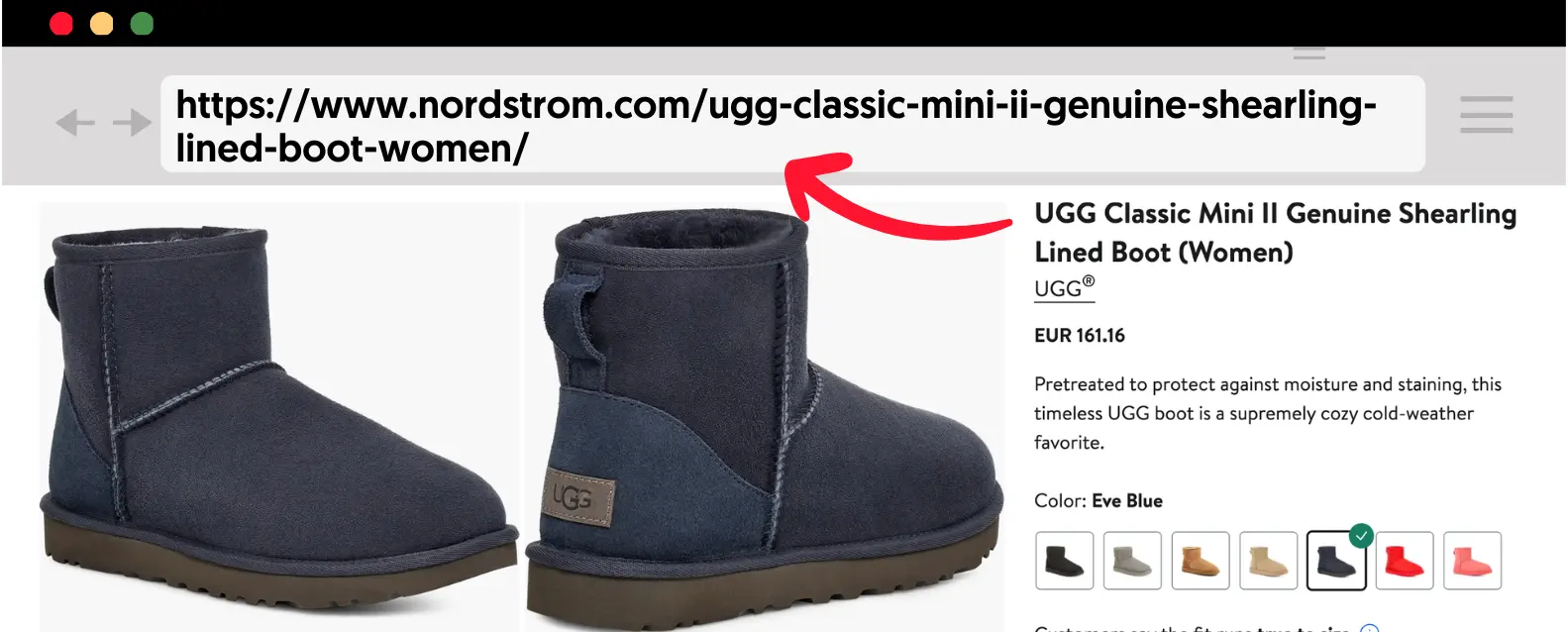
If you have a lot of products or it's too difficult to change your URLs, don't spend too much time on this. There are more significant SEO changes to improve your online shop.
If you are up to the job, then make sure that for each product URL, you add a 301 Redirection so that the old URL is redirected to the new URL. Read this article for more details on how to do the redirections.
2. Optimize Product Titles
The next step is to work on your product titles. This is one of the most important optimization tasks you can do for your eCommerce pages.
Follow these best practices:
- Each product should have a unique title.
- The title should combine details about the product and keywords in 60 characters or less.
- You don’t need to add your domain name to your title, as Google does this automatically.
- Use this format: brand name, model, and keywords. For example, "Racer Women's Shoes'.
How do you combine product names and keywords in the title?
The first step is to refer to the results of your keyword research. Having a clear idea of what search terms people type in the Google search box is essential.
Let's say that you are selling shoes, and you know from the keyword research that people search for "men's running shoes." Your first action is to optimize your category page for that term. It's a general term and a great candidate for category optimization.
Then, you can use your keywords to optimize your product page titles based on the format: brand name, model, and keywords. Here is an example:
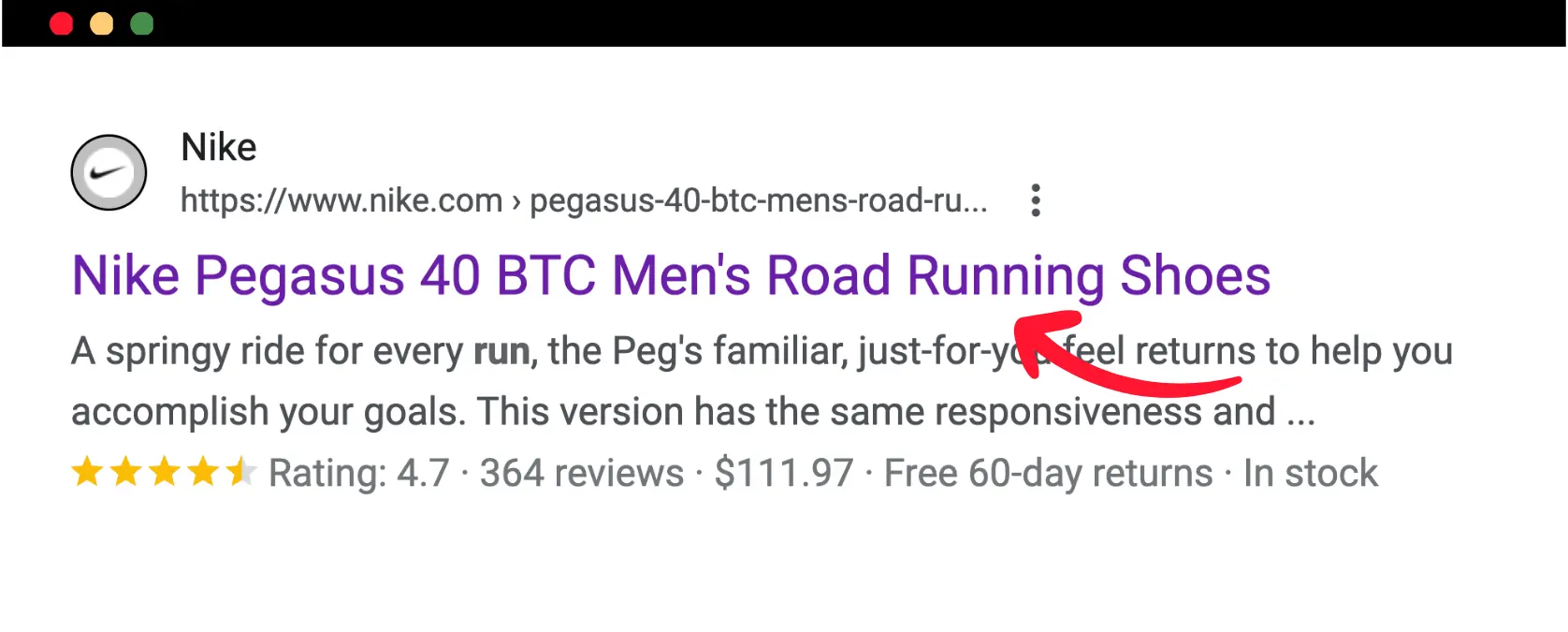
If you are selling products in which the brand name is not important, you can change the order of the words in the title to include the keywords first and then the brand or type.
Here is an example from Amazon.
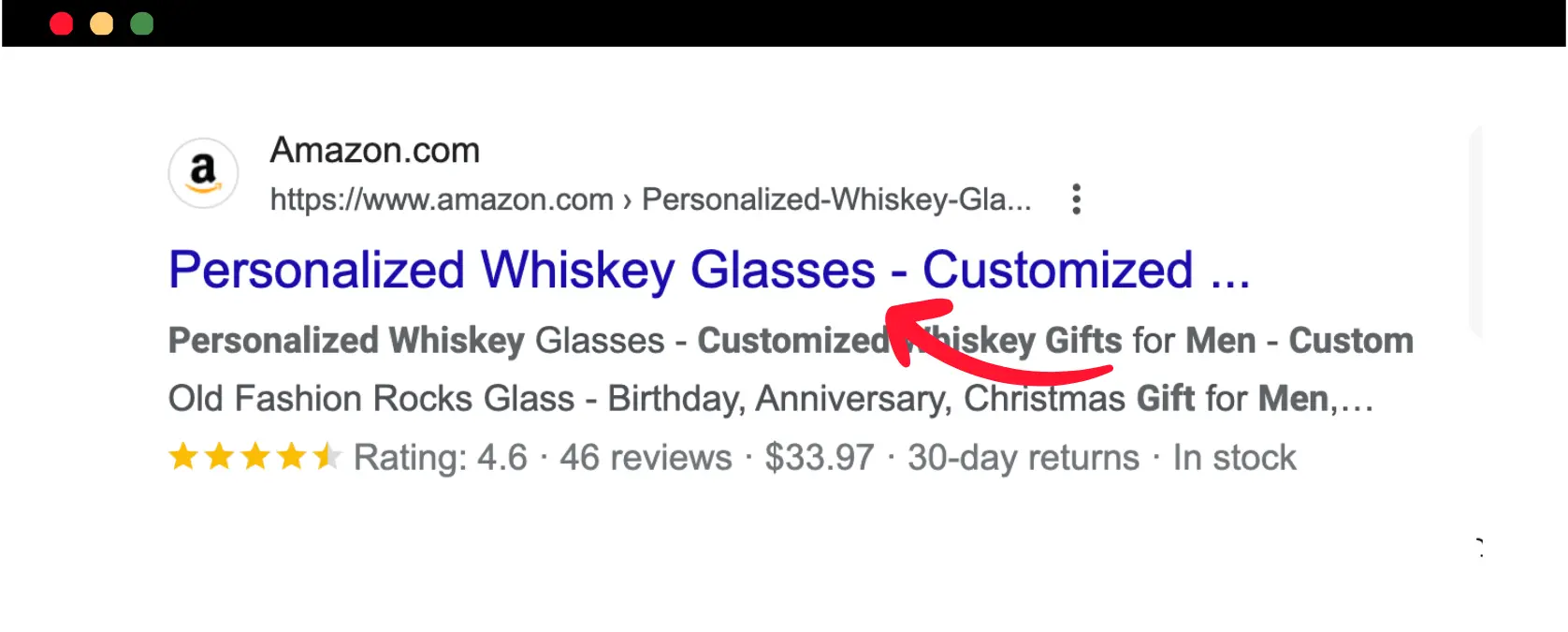
3. Enhance Product Page Headings
A product page has several headings organized in a hierarchical format. The H1 tag should come first, followed by an H2 tag and H3 tags.
Here is an example where the top heading (H1) has the product name, and H2 is used for the product type.

It is a common practice for the H1 tag to be the same as the title tag. Remember that the title tag is shown on the SERPs, not the page, while the H1 tag is shown on the page.
While this is okay (and the default configuration for many eCommerce shops), you can differentiate their values if you want. This will allow you to enrich your page with related keywords. What is more important is to use descriptive headings to help users and search engines scan your pages better.
Besides that, the other thing to check and ensure is that your page has only one H1 tag, which is located high on the page and above the different headings (h2, h3, etc.).
4. Craft Compelling Meta Descriptions
Google guidelines for meta description optimization state the following:
- Provide a unique description for every page of your website, and that includes product pages.
- Write descriptions that accurately describe the page content in 160 characters or less.
Google will not always use the value provided, but it might pick up text from the page and show it as a meta description.
The problem is that on some occasions, the text shown by Google as the description is not attractive to users, and thus, you lose clicks (and potential customers).
So, it's better to take advantage of meta descriptions and make your search snippets exciting and inviting for the users to click and visit your product pages.
What should be included in your product meta description?
A description needs to include the product name and keywords. As you can see in the examples below, Google highlights the keywords from a description that matches the user's query.
You can also add benefits like free shipping and returns, a money-back guarantee, and additional information that can differentiate your snippet entry from the rest.
The snippet from Zappos below is an excellent example of an optimized meta description.
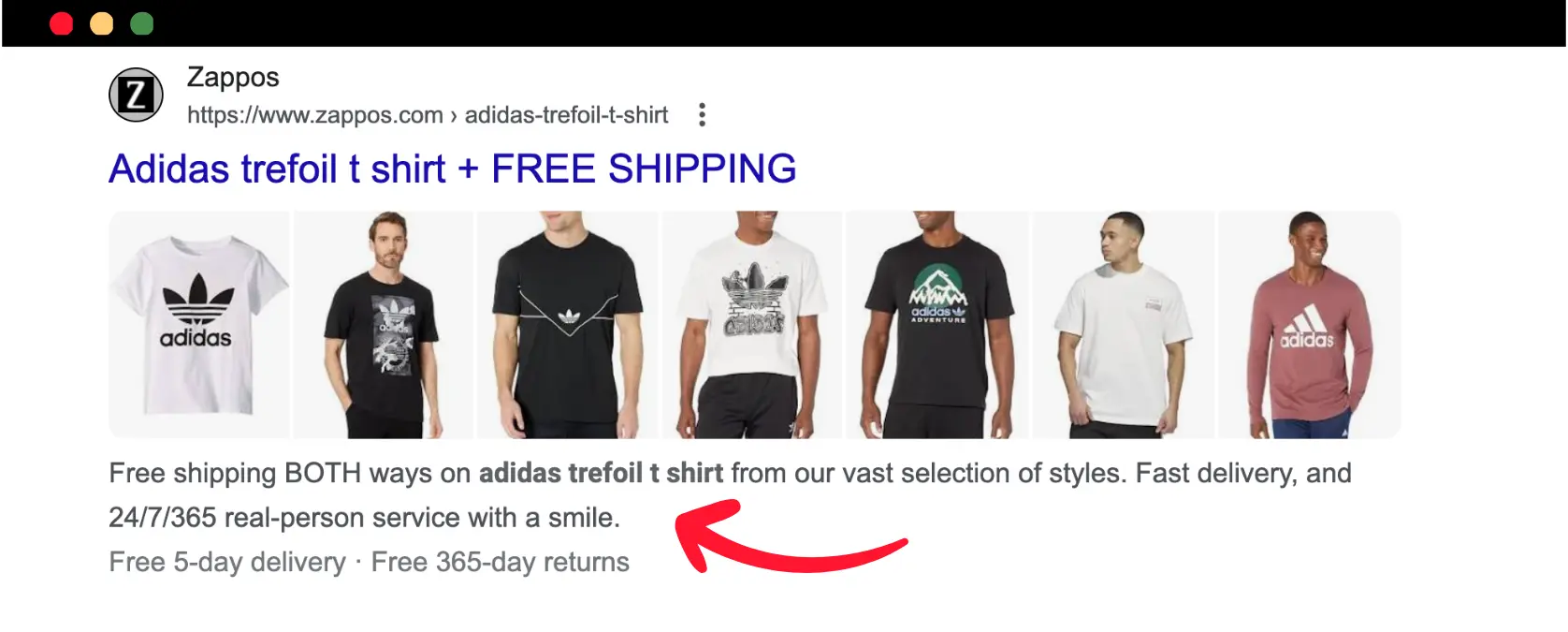
5. Improve Breadcrumb Navigation
Breadcrumb menus are essential for user-friendliness and the usability aspect of an eCommerce website.
A good breadcrumb trail should allow users to easily return to the home page or primary categories. A hierarchical website structure improves user engagement and helps SEO by organizing and linking content hierarchically.
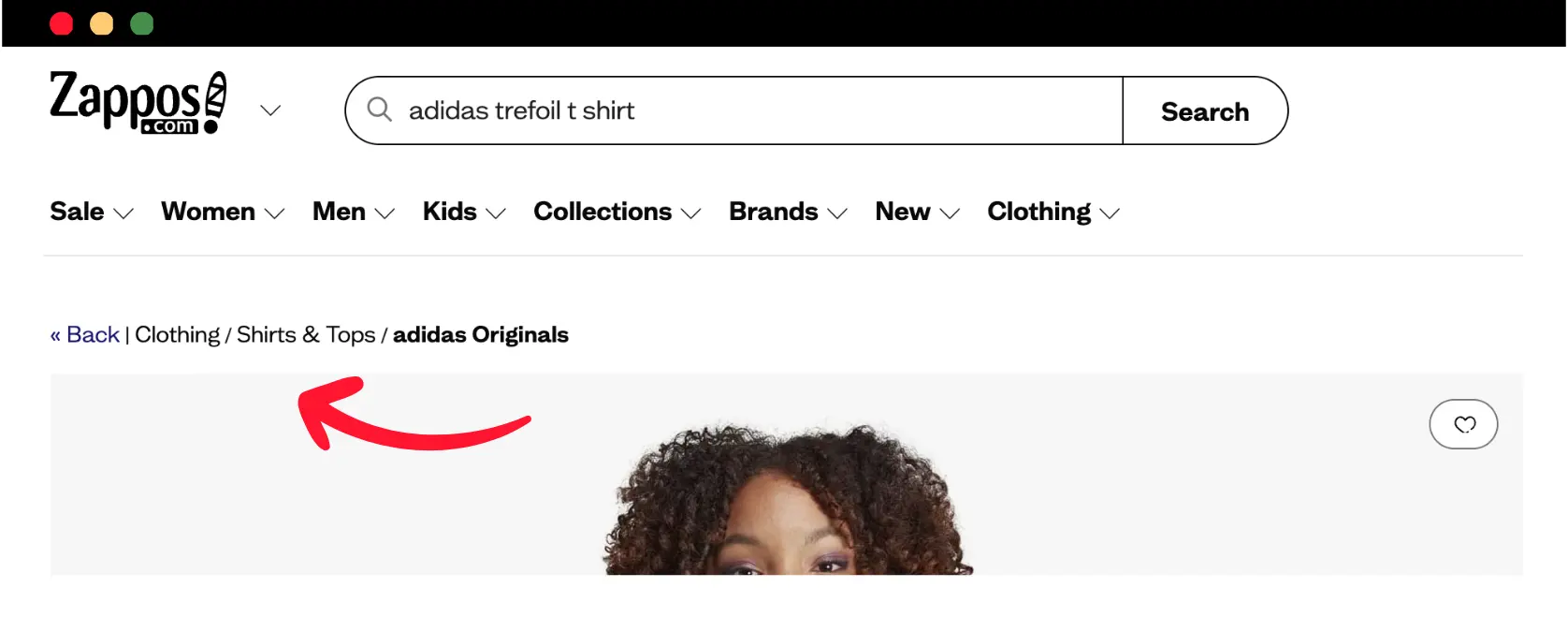
Breadcrumbs also contribute to higher CTRs (click-through rates) because they enhance the presentation of your snippet in the SERPS. To take advantage of this, breadcrumbs must have the proper structure data so that Google can understand them.
Look at the example below and see how Google uses the breadcrumb information instead of the product URL in the snippet.
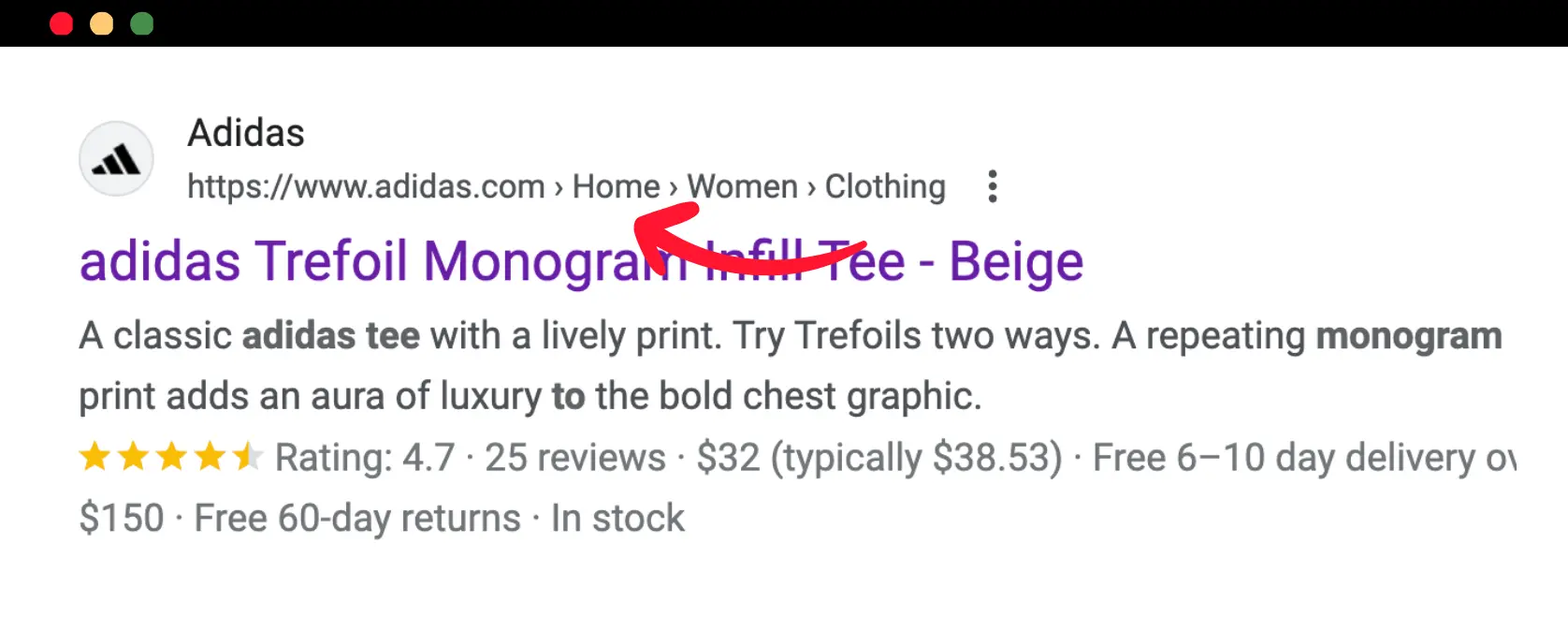
It's more relevant and can contribute to more clicks. For more information on how to optimize your breadcrumb trail, read Breadcrumbs SEO.
6. Write Unique Product Descriptions
Optimizing your product descriptions is one of the most challenging and time-consuming tasks, especially if you have a lot of products in your eCommerce store. From experience, it's also one of the tasks most eCommerce owners get wrong.
Follow these tips to optimize your product descriptions.
Unique Content - Each product should have a unique product description. If your product description is an exact copy of what is already available on other eCommerce websites on the Internet (including the manufacturer page), Google will ignore your product pages.
Google does not penalize websites because of duplicate content but does not reward them. An eCommerce website with many pages with duplicate content is considered a low-quality website, and the chances of ranking high for competitive terms are minimal to none.
So, the first thing that you need to do is to ensure that your product page description is unique. Uniqueness is not limited to websites across the web but to your website, too. In other words, every product in your shop needs to have a unique description and not the same description as another product within your shop.
Content length - There is no golden rule regarding the number of words your product description should be. Your goal with eCommerce websites is to make sales, so your product descriptions should primarily serve that purpose.
The advantage of providing long descriptions is that with the proper On-Page SEO techniques, you can blend keywords into your text and make your product pages search-engine friendly and interesting for the users.
Look at any product on Amazon. They have a ton of content related to product usage, product short and long descriptions, customer reviews, Q&A related to the product, and many other helpful information.
Amazon is not doing this for SEO purposes but because it helps users to make a purchase decision.
Content Optimization - While writing your product descriptions, don't forget about optimizing your content. The best way to do this is to go back to the results of your keyword research and make a list of keywords that are related to the specific product.
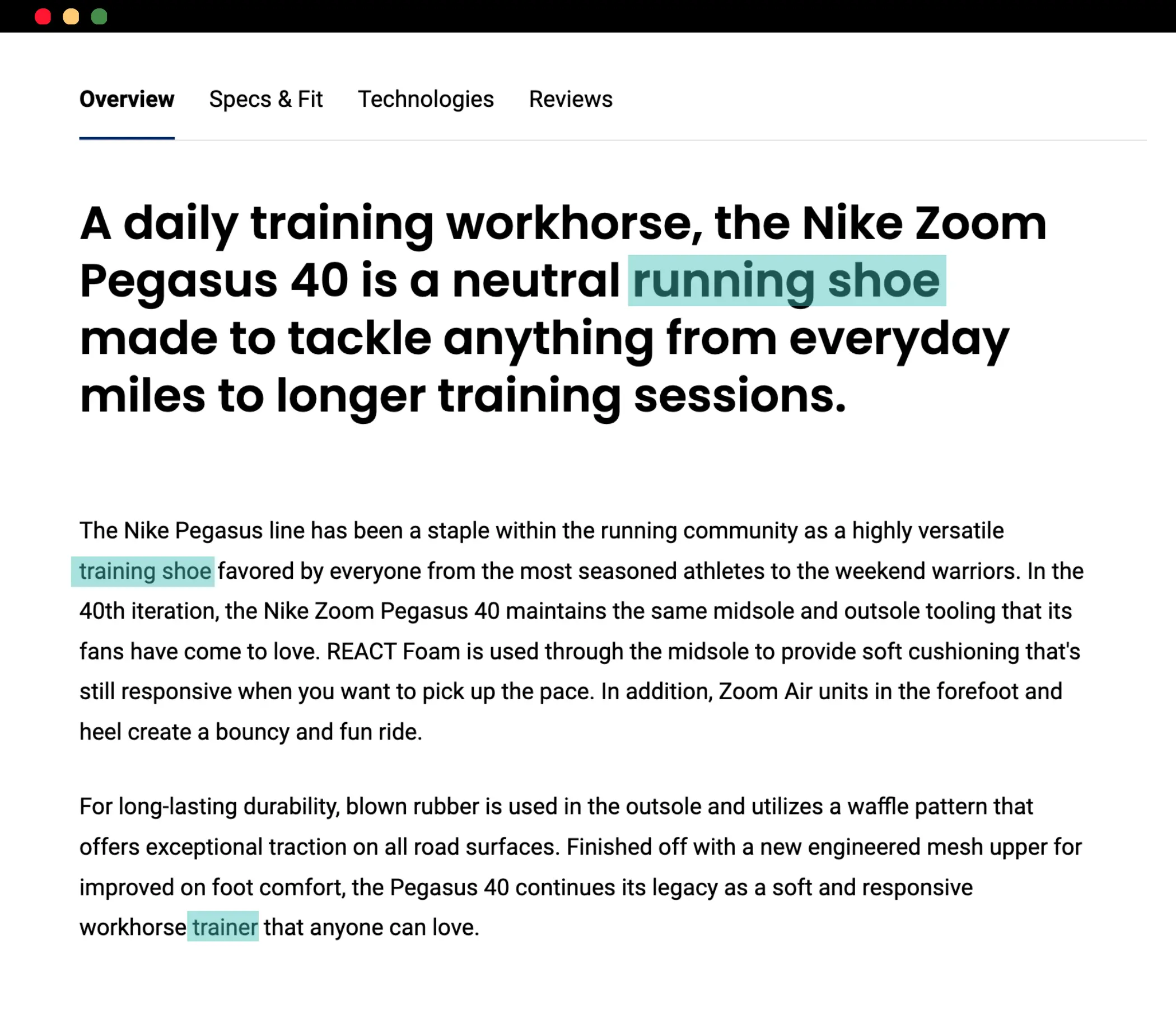
Use those keywords in your headings and text naturally without doing keyword stuffing. Mentioning your target keyword a couple of times in the text is enough, and using related keywords from your list in the headings will help Google understand what the page is all about.
You can link to related products within the text, but be wise; you don't want to drive people away from your product page. Your goal is to keep them as much as possible on the page so that they eventually proceed with a purchase.
7. Use High-Quality Images
Images are necessary components of your product pages. Regardless of the type of products you are selling, your product pages must have images.
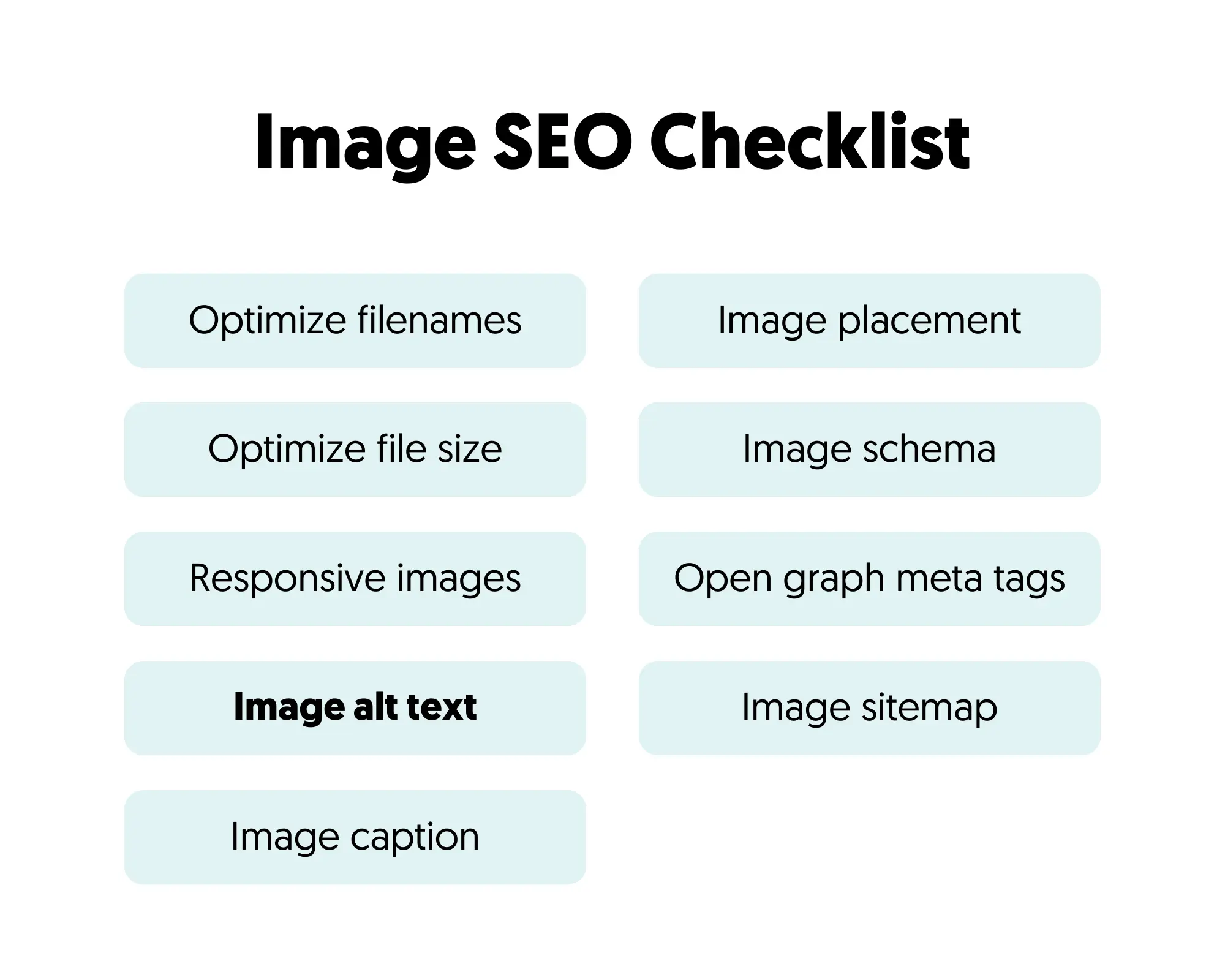
Some tips to optimize your eCommerce product images:
Use authentic images– using images that are not of good quality can drive customers away. If you cannot create original images of your products, then make sure that you select high-quality images that look authentic.
Provide meaningful file names – Image filenames are NOT among the most significant SEO factors, but having proper filenames can help you manage the (possibly) hundreds of images in your store and increase your chances of ranking in Google image search. Using keywords naturally in your image filenames is a good practice to follow.
Optimize your ALT Text – Alt text is the most critical element of image optimization. It serves two primary purposes. It is shown in the browser until the images are fully downloaded, and it is essential for SEO since it's through the ALT text that search engines can understand what an image is all about.
When optimizing your image alt text:
- Use natural language – plain English, as you would explain to a friend what the image is all about.
- Use a short caption below each image to give search engines and users more information about the image.
Optimize the image file size -
The size of the images does matter. Smaller images are faster to download, while large images may slow a website down. Use tools like image optim to optimize their size without sacrificing quality.
8. Add Product Videos Properly
Where possible, try to use Videos to make your product content more engaging. People love videos, and good original videos can differentiate your shop from competitors and increase conversions.
You can use videos from the product manufacturers (if available), but the best approach would be to create custom videos for your products.
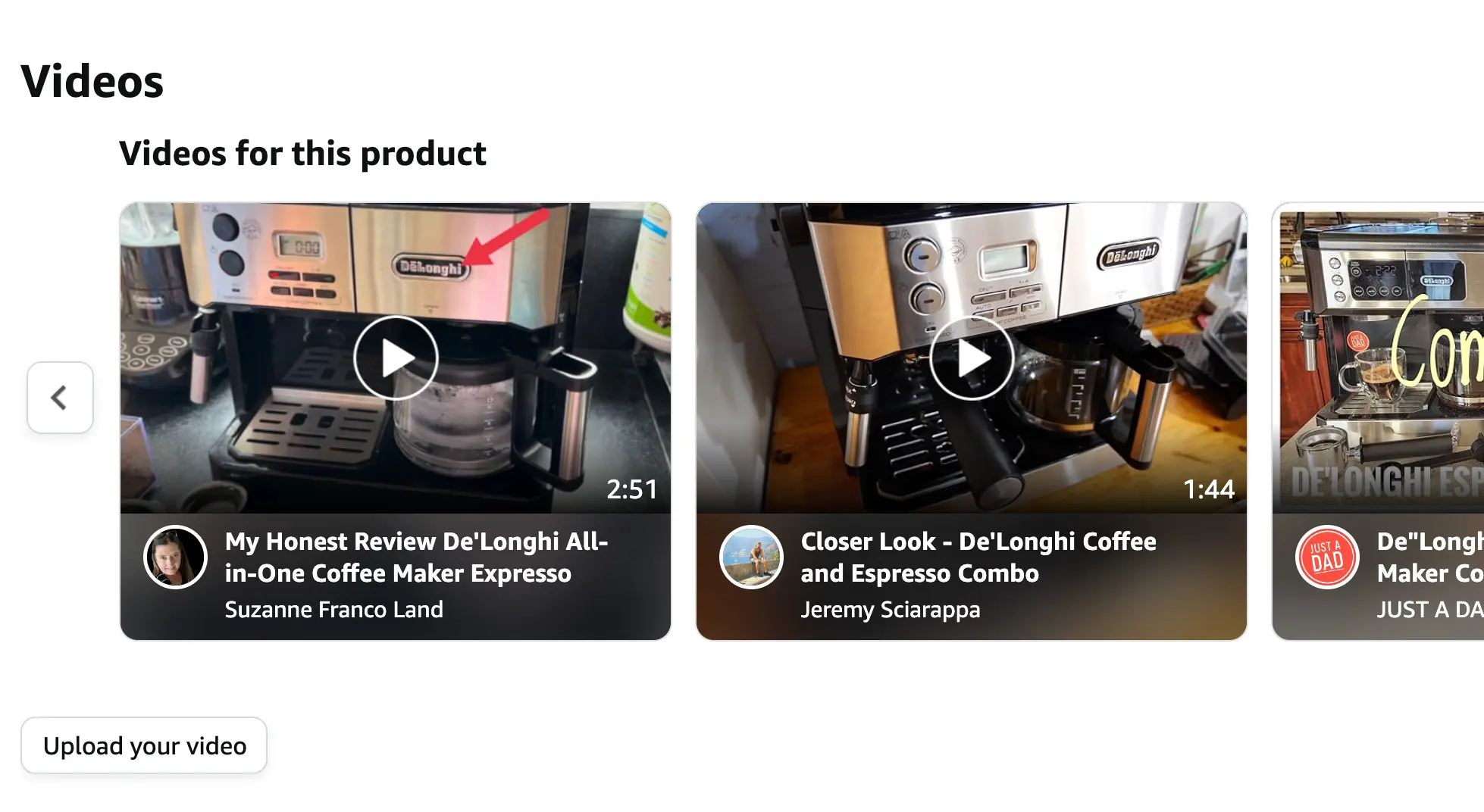
Whichever the case, here is your video SEO checklist:
- Do not upload videos directly on your server. Instead, use a dedicated video hosting service like YouTube or Vimeo. Once uploaded, there are various ways to embed the videos in your product pages.
- Wrap your videos with Video Schema markup.
- Create a video sitemap and submit it to Google.
9. Implement Product Schema Markup
Product schema or structured data is a way to highlight specific data from your product pages (such as the product name, price, availability, reviews, and ratings) so that search engines can read and understand this information more easily. It's another way to enhance your snippet in the SERPS and get higher CTR (click-through rates).
Google uses product information in several places, such as Google Search, Google Shopping, Knowledge panels, and Google Images.
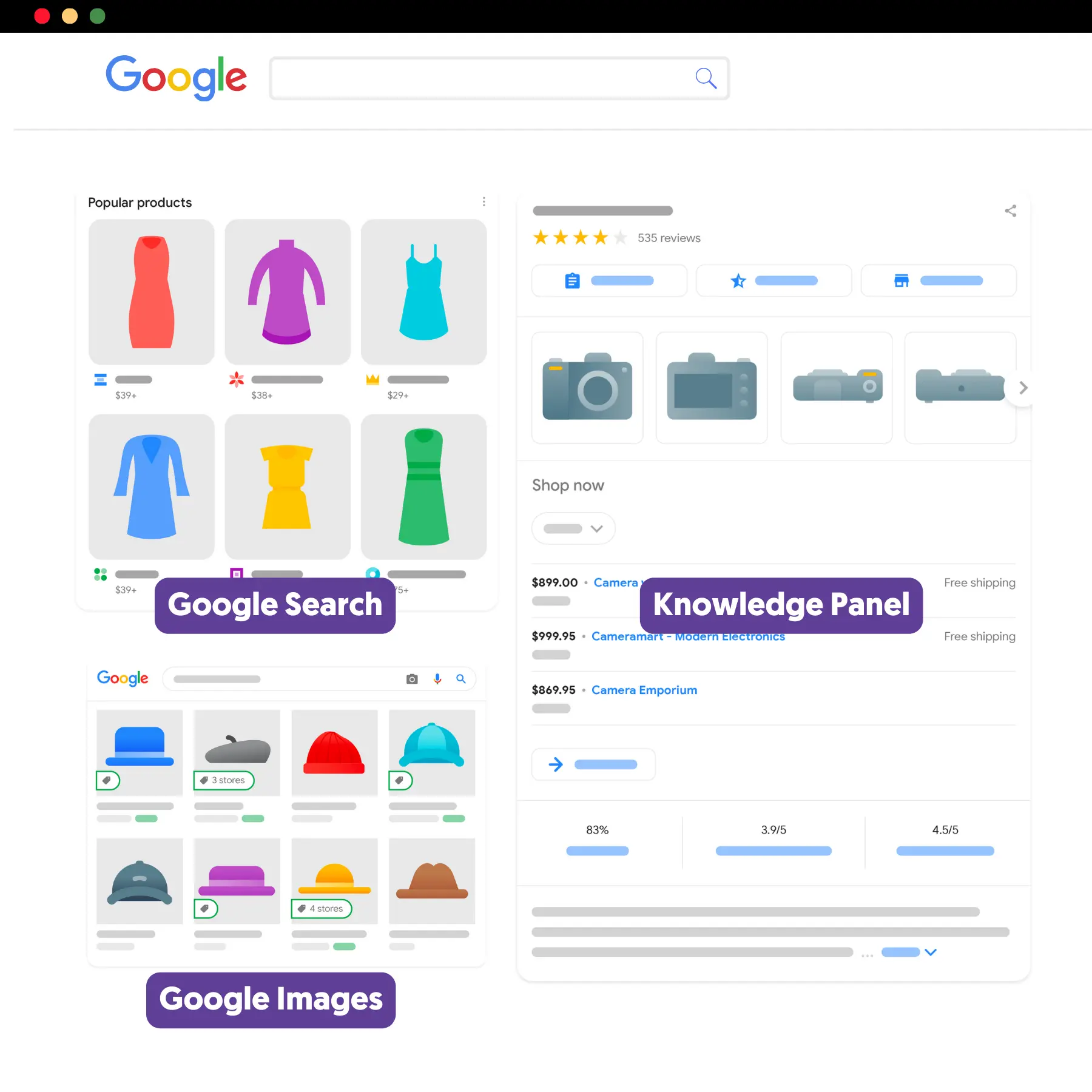
When the product schema is configured correctly, your search snippet will include the item's price, reviews, and stock information, as shown in the examples above.
How do I add product schema?
It depends on the eCommerce platform you are using. Most modern eCommerce CMS (like Shopify or Woocommerce) have product schema built-in.
The first thing to do is to go to the rich results testing tool and enter the URL of one of your product pages. If your product pages are missing structured data, the best way to add them is to use the JSON-LD format. Use the resources below to get step-by-step instructions.
Structured data is heavily used by Voice Search Systems (like Google Assistant), which is another good reason to implement structured data in your store.
10. Highlight Product Reviews And Ratings
Product reviews are among the 'must-have' components of successful product pages. It is statistically proven that product pages with real, positive reviews are more likely to have higher conversion rates than product pages with no reviews.
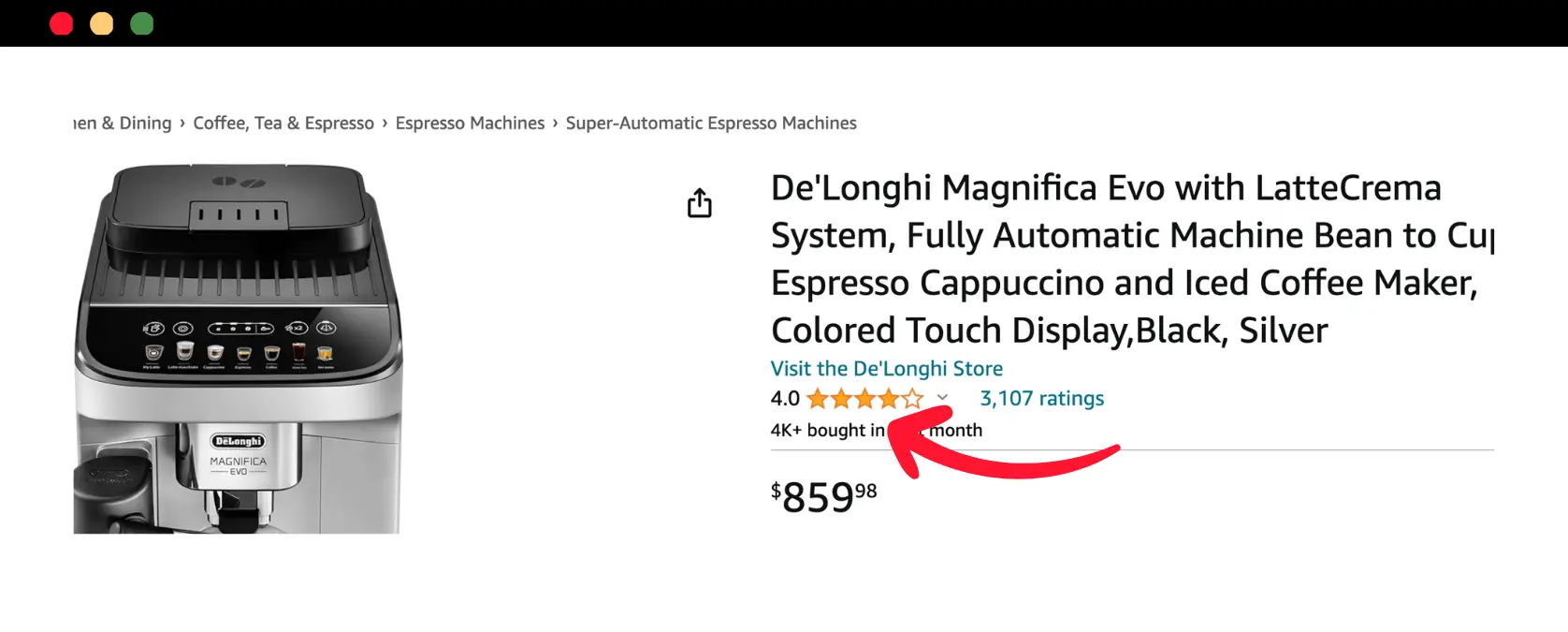
Follow these best practices:
- Add Star Ratings and total reviews below your product title. See the example of Amazon. When clicked, it should go to the "Reviews" section at the bottom of the page.
- Ensure your product reviews are on the same page as your products (don't use a different review page for each product).
- Show the latest reviews first. People like to read recent reviews and not outdated reviews.
- Try to provide as much information as possible about the reviewer. If possible, have their photo and name to accompany the review.
- Don't make the mistake of adding reviews without proof. Users can easily spot fake reviews, and this can generate the opposite results.
- Use product review schema to improve your presence in Search (or Google Ads)
Third-Party Reviews -
I have mentioned above that you need to make every effort to make your reviews look real. One of the best ways to achieve this is to use a third-party review system.
Reviews posted publicity on third-party sites are more trusted by the user (and Google) because they cannot be manipulated. Here is a list of the most popular review systems you can use.
- Google Reviews
- Google Business Profile Reviews
- Facebook Reviews
- Better Business Bureau (BBB) Reviews
- Trustpilot
- YotPo
- BizRate
11. Leverage User-Generated Content
One of the ways to have unique content on your product pages is user-generated content (UGC).
User-generated content is what the name implies, i.e., content generated by users, usually in the form of questions and answers. Here is an example from a popular online store.
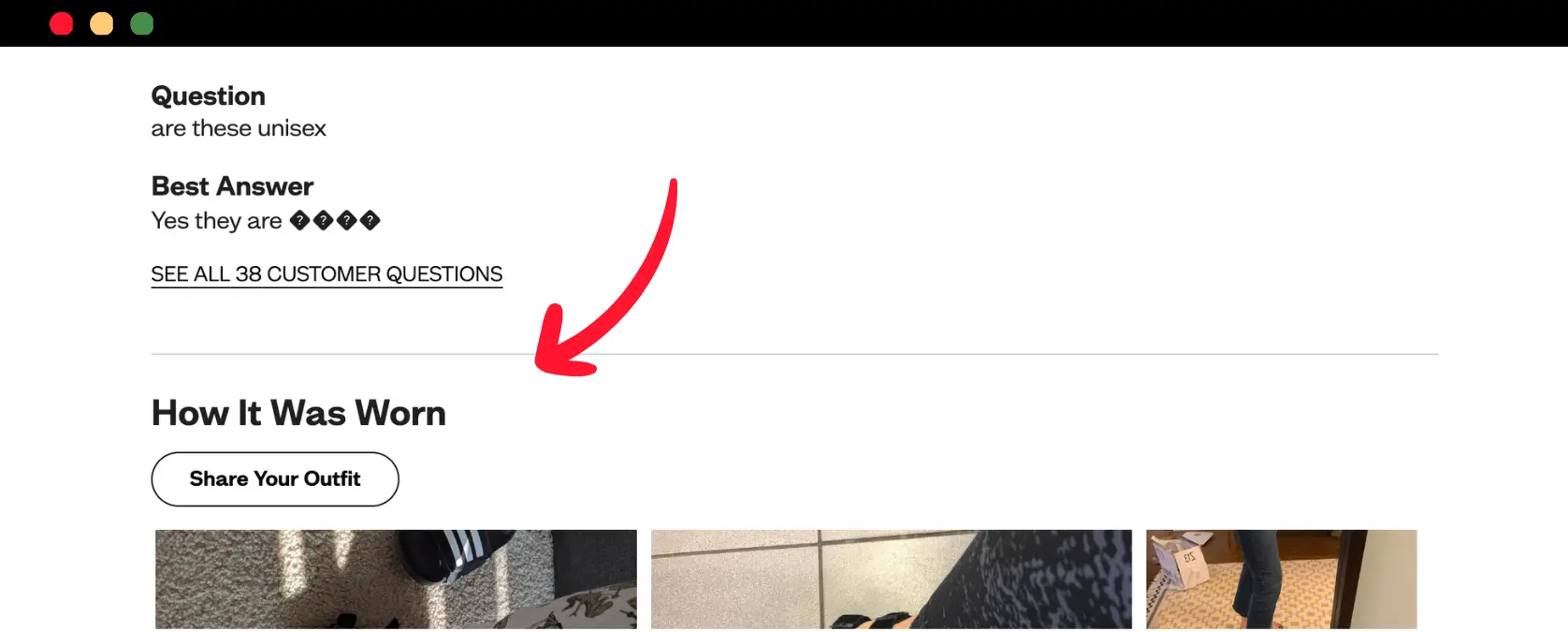
There are a few things to note about user-generating content from an SEO perspective.
- Make sure you disallow users from entering links in the comments (allow only text). The last thing you want is for spammers to fill your pages with spammy content and links.
- Monitor all replies before publishing. Publish only questions and answers that are highly relevant to your product.
- Don't fill your page with Q&A content. Show 4 or 5 questions, and then redirect the user to a dedicated page (or to a hidden tab) for more questions.
"User-generated content" is not always easy to achieve. You need to have popular products and a system in place to email existing customers questions your potential customers have.
Nevertheless, if you can have this feature, it will be helpful for your SEO and customer support.
12. Strategize Cross-Selling
Another element to enhance your product page SEO is adding related items. Showing users related products, besides generating more sales, is also a great way to add internal links to your product pages.
If you go to any popular online store, you will notice that below each product, sections display matching products or what other people have purchased related to the viewed product.
Here is an example from a shoe store:
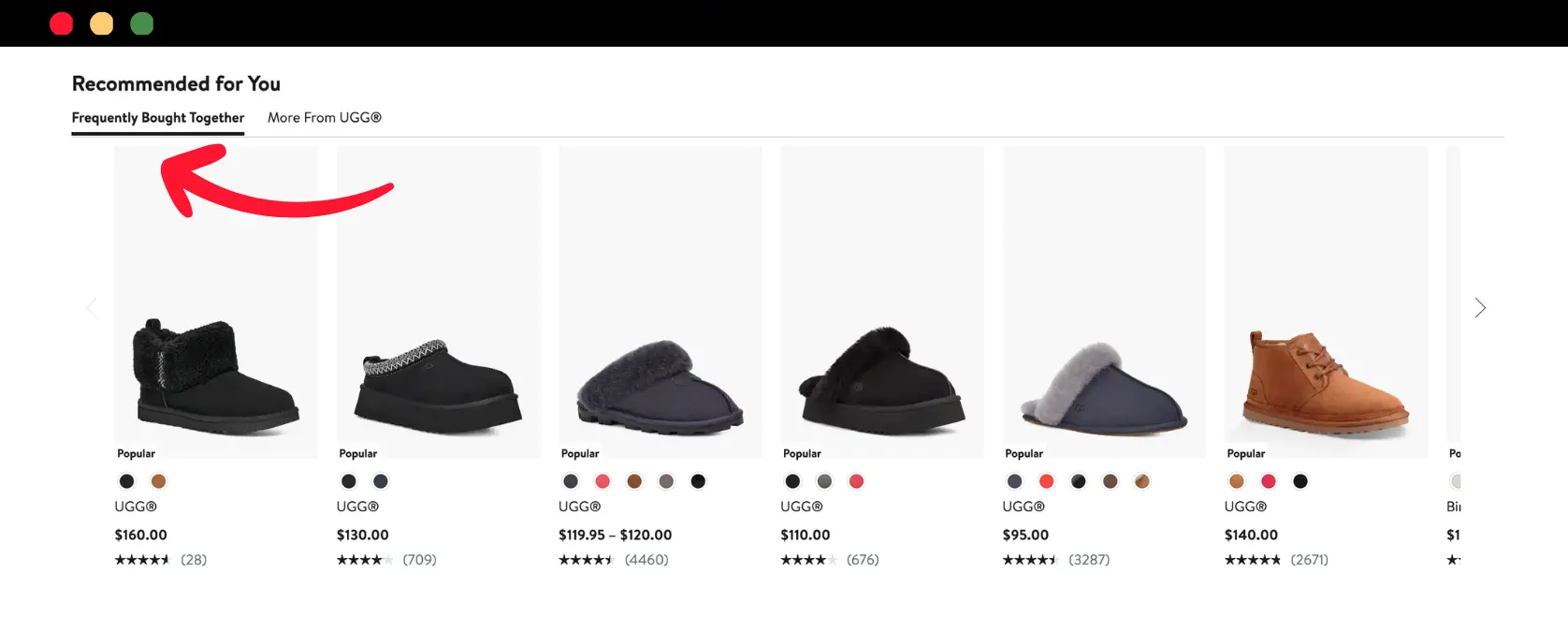
Key Learnings
Product page SEO is not as difficult as it sounds, and as mentioned in the introduction, it's not just about SEO.
When SEO optimizing your product pages, you should have four things in mind:
- Your Users (usability).
- The accurate representation of your brand and products.
- Conversion Optimization.
- Search Engine Optimization.



